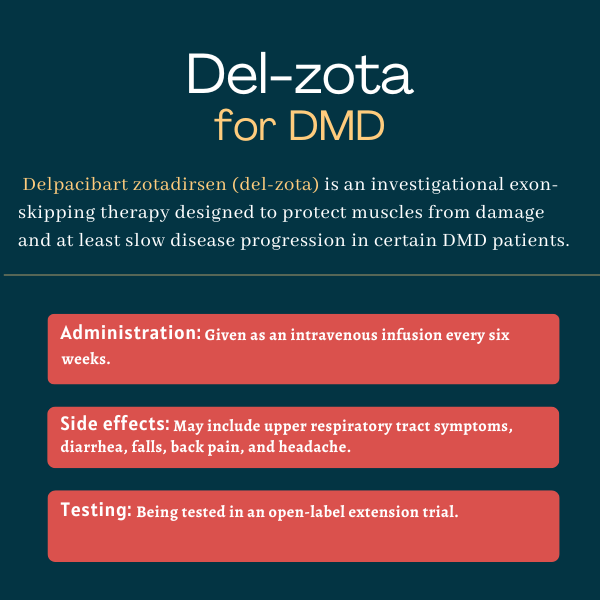Del-zota for Duchenne muscular dystrophy
Last updated Oct 10, 2025, by Margarida Maia, PhD

What is del-zota for Duchenne muscular dystrophy?
Delpacibart zotadirsen (del-zota) is an investigational therapy for Duchenne muscular dystrophy (DMD) caused by mutations amenable to exon 44 skipping. It is being developed by Avidity Biosciences.
Duchenne is caused by a faulty DMD gene, which encodes dystrophin, a protein that protects muscles from wear and tear during movement. Without it, muscles become damaged over time.
Delivered as an intravenous, or into-the-vein, infusion, del-zota contains an antibody that targets muscle cells and a molecule called a phosphorodiamidate morpholino oligomer, or PMO, so that the protein-producing machinery in muscle cells skips over a portion of the DMD gene (exon 44) to produce a shorter but functional version of dystrophin. This is expected to protect muscles from damage and at least ease symptoms.
Therapy snapshot
| Treatment name: | Delpacibart zotadirsen (del-zota) |
| Administration: | Intravenous infusion |
| Clinical testing: | In an open-label extension trial for DMD |
How will del-zota be administered?
In adults and children with DMD, del-zota has been tested as an intravenous infusion at either 5 mg/kg or 10 mg/kg. The company has selected the lower dose, given every six weeks, for further clinical testing, and for a planned biologics license application seeking regulatory approval in the U.S.

Del-zota in clinical trials
After completing a Phase 1/2 clinical trial dubbed EXPLORE44 (NCT05670730), the company is continuing to test del-zota in an open-label extension called EXPLORE44-OLE (NCT06244082), which has enrolled 39 men and boys diagnosed with DMD.
- In the EXPLORE44 clinical trial, men and boys with DMD were randomly assigned to receive infusions of del-zota — 5 mg/kg every six weeks or 10mg/kg every eight weeks — or a placebo. Top-line results showed that production of dystrophin increased to about 25% of its normal levels with either low or high doses. Treatment also reduced levels of creatine kinase, a marker of damage to muscles, in the blood by more than 80%, a benefit sustained for up to 16 months, or nearly 1.5 years.
- In the ongoing EXPLORE44-OLE, patients who were being treated with the 10 mg/kg dose every eight weeks were switched to the lower dose of 5 mg/kg every six weeks. At about one year of follow-up, pooled data from the parent trial and the OLE showed benefits in multiple timed function tests and in the North Star Ambulatory Assessment of motor function relative to a natural history group of patients not treated with del-zota. Benefits were also reported in a measure of upper limb function regardless of the participants’ ability to walk.
Del-zota side effects
Most side effects reported with del-zota during clinical testing were mild or moderate in severity. The most common ones were:
- upper respiratory tract symptoms
- diarrhea
- falls
- back pain
- headache
Muscular Dystrophy News is strictly a news and information website about the disease. It does not provide medical advice, diagnosis, or treatment. This content is not intended to be a substitute for professional medical advice, diagnosis, or treatment. Always seek the advice of your physician or other qualified health provider with any questions you may have regarding a medical condition. Never disregard professional medical advice or delay in seeking it because of something you have read on this website.
Recent Posts
- Hope takes center stage as musical honors healthcare professionals
- 3-drug cocktail boosts DMD gene therapy effectiveness in mice
- The holiday season makes me regret not making my kids do chores
- Rainy days, Mondays, and FSHD make feeling grateful a challenge
- Myotonic dystrophy drug SRP-1003 trial advances to higher doses






